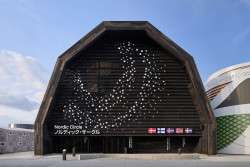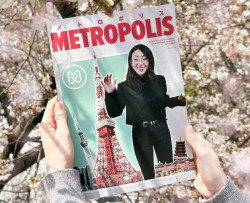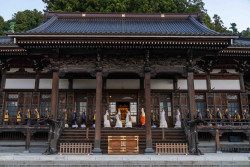
Originally published on metropolis.co.jp on April 2013
What’s not to love about Tokyo’s busiest line? It runs every three or four minutes, the last train is seriously late, and if you fall asleep for an hour—you’ll wake up right where you left off. But even these benefits are out-shined by the sheer amount of great ramen within a few minutes walk of its stations. Whether you’re doing business around Tokyo station, studying in Takadanobaba, or checking out the red lights of Shinjuku, a hot bowl is never a problem.
See “Soupy Styles” at the bottom of the piece for a brief guide on the key ramen types.
Don’t agree? Add your noodlings in the comments below the article.
Nagi Golden Gai / 凪 ゴールデン

Shinjuku
The Nagi group of ramen shops has a few locations around Tokyo, but its Golden Gai branch is unique. Stuffed in on the second floor above an equally narrow bar, the shop is open all night to serve the best hangover-prevention medicine known to man: niboshi ramen (煮干ラーメン, ¥750). A pinch of dried sardines is often added to ramen for a slightly bitter, fishy flavor. But the pinch becomes a punch at this regular stop for Kabukicho revelers.
2F, 1-1-10 Kabukicho, Shinjuku-ku. Tel: 03-3205-1925. Open 24/7, closed every 3rd Mon. www.n-nagi.com
Fuunji / 風雲児

Shinjuku
Fuunji (the lucky traveler), located on a side street near Shinjuku’s south exit, always has a line out the door. Don’t let this discourage you (and don’t mind the fact that the line continues inside). This is Tokyo’s best tsukemen (つけめん, ¥750) vendor. The master slow cooks chicken bones for hours before blending the result with choice Japanese dried fish for a smoky, creamy soup worth the wait.
2-14-3 Yoyogi, Shibuya-ku. Tel: 03-6413-8480. Open Mon-Sat 11am-3pm & 5-9pm, closed Sun & hols. www.fu-unji.com
Afuri / アフリ

Harajuku, Ebisu
Popularizing a new style of ramen is no easy task. Popularizing something for the ladies is even harder. Afuri breaks into the male-dominated ramen scene with its light and refreshing—some would even say “healthy”—soups. The yuzu citrus-tinted shio ramen (yuzu shiomen, ゆず塩麺, ¥850) ensures a host of repeat customers. A newly opened shop in Harajuku makes a nice stop after that Omotesando Hills shopping spree.
1-1-7 Ebisu, Shibuya-ku. Tel: 03-5795-0750. Open daily 11am-4am.
3. Hayashi / はやし

Shibuya
You might expect Shibuya to be brimming with excellent ramen, but the hippest stop on the Yamanote is surprisingly lacking. The best of the bunch is Hayashi. The menu is a scant three items deep. Ramen, ramen with an egg, and ramen with extra pork and egg (yakibuta ramen, 焼き豚らーめん, ¥1,000). The shoyu and rich pork soup is, simply put—golden. One drawback, especially for the nocturnal eaters, is that Hayashi is only open for a few lunchtime hours a day.
1-14-9 Dogenzaka, Shibuya-ku. Tel: 03-3770-9029. Open Mon-Sat 11:30am-2:30pm, closed Sun & hols.
6. Junk Garage / ジャンクガレッジ

Tokyo
Tokyo station is home to Tokyo Ramen Street, where you can enjoy eight great shops without leaving the building. Though almost all are recommended, Junk Garage stands out. This is junk-kei (junk-style) ramen that looks either fantastic or awful, depending on your taste. The signature dish is a soupless noodle (maze soba, まぜそば, ¥750), topped with raw garlic, cheese, spicy-mayo babystar (a dried-ramen snack), massive pork slabs, a raw egg, and a dollop of pork back fat. Mix, and save the diet.
B1F, Tokyo Station Yaesu south exit, 1-9-1 Marunouchi, Chiyoda-ku. Tel: 03-3286-0167. Open 11am-10:30pm. www.tokyoeki-1bangai.co.jp/ramenstreet
5. Kikanbo / 鬼金棒

Kanda
Spicy ramen is easy to find in Tokyo; most shops have a 辛 (karai) or 赤 (red) version on the menu. Kikanbo has nothing but. In fact, its ramen comes topped with two different spice blends. The kara spice is the shop’s own blend of 11 secret spices from around the world, and the shibi is ground Chinese numbing pepper. Choose your level, from light to oni-meshi (devil-like). The pick is kara-shibi miso ramen (カラシビ味噌らー麺, ¥780), matching the Japanese demon-mask décor.
2-10-10 Kajicho, Chiyoda-ku. Tel: 03-3256-2960. Open Mon-Sat 11am-9:30pm & Sun 11am-4pm. http://karashibi.com
7. Tsumugi / らーめん紬麦

Akihabara
Finding Tsumugi is tough; it’s in the basement of a nondescript Mitsui building on Akihabara’s boring east side—no maid cafés and cheap electronics here. It’s worth it, though; the noodles are made with 100% sanuki flour from Shikoku. Usually reserved for udon, this glutinous flour gives the ramen a firm, chewy texture. The standard bowl is great, but the Tsumugi ramen (つむぎラーメン, ¥850) blends in a little spice and vinegar, enhancing the noodles even more.
B1, Dai San-Higashi Bldg, 1 Kanda Hirakawacho, Chiyoda-ku. Open Mon-Fri 11:30am-2:15pm & 6pm-8pm, Sat 11:30am-4pm, closed Sun & 2nd & 4th Sat.
8. Kamunabi / 神名備

Nishi-Nippori
A bit of a walk from the station (if you consider ten minutes a feat of endurance), Kamunabi is a north-side star. At first the pricey chashyu ramen (チャーシュー麺, ¥1,575) looks a bit dry. It is this dryness, though, that holds all the flavors of the soup. Check the opening hours, as it’s often closed.
4-21-3 Sendagi, Bunkyo-ku. Open Wed-Fri 11:30am-2:30pm & Sat-Sun 12pm-3pm & 6pm-9pm, closed Mon & Tue.
9. Torinoanna / 鶏の穴

Ikebukuro
What better food on a cold day than thick chicken-soup ramen? The key is the time it takes to cook the soup. While a clear broth may take only a few hours, a creamy paitan like this is often an overnight endeavor. The ramen with Torinoanna’s signature logo-branded egg is excellent (shiratori, 白鶏らーめん, ¥700 + hanjukku ajitsuke tamago, 半熟味付け玉子 ¥100).
1-39-20 Higashi Ikebukuro, Toshima-ku. Open 11am-10:30pm. Tel: 03-3986-2811.
10. Watanabe / 渡なべ

Takadanobaba
New shops open monthly in this ramen battle zone with hopes of making it big. Some last, some don’t. But Watanabe has stood the test of time. The signature topping is a brick-sized piece of menma—pickled bamboo—that looks like it should come with a steak knife. Everything about this dish is intense (ramen, らーめん, ¥800). The noodles are thick, the egg is hearty—even the bowl is rustic. Sure, a lot of great shops are closer to the station, but Watanabe is worth the short trek.
2-1-4 Takadanobaba, Shinjuku-ku. Open 11am-8pm. Tel: 03-3209-5615.
Soupy Styles
Shoyu 醤油
The base here is a soy tare; a concentrated sauce made with all sorts of tasty things. Seaweed and dried fish are quite common, but the possibilities are endless. Shoyu ramen tends to be a bit rustic in taste, and a simple, hot bowl can invoke natsukashi nostalgia in many locals.
Miso 味噌
Though Sapporo is famed for miso ramen, shops all over the country have experimented with a variety of fermented bean pastes as base. The best shops take ones that are perhaps a little sweet, and others maybe a little salty, and create secret blends. Though it is technically miso soup, if your ramen tastes anything like the popular breakfast broth, the shop is doing something very, very wrong.
Shio 塩
Shio, literally salt, ramen is often just shoyu ramen without the shoyu. The best shops, though, have taken the lightness into account and matched this style with seafood and citrus. Many of the top ramen critics in Japan have said that you can only truly tell the skill of a ramen chef by his ability at making shio ramen.
Tonkotsu 豚骨
Though pork bones are used in almost all ramen soups, tonkotsu ramen as a style means creamy and thick. The bones are cooked at high heat for many, many hours—sometimes over 12. This process brings out all of the collagen from the bone marrow. The resulting mixture is packed full of umami goodness, but sometimes at an expense. You can smell many popular shops from a kilometer away.
Soupy Seconds
King Kong in Ikebukuro
Porky tsukemen made with a touch of blueberries, of all things
Sengoku Jiman in Sugamo
Heavy tonkotsu shoyu soup with a lot of seabura (pork back fat)
Daiki in Ueno
The chicken shio ramen here is a long-running favorite
Rashohon in Kanda
The best tantanmen in Tokyo
Zoot in Hamamatsucho
A ¥1,500 wine nomihodai seals the deal on an otherwise fine bowl
Gacchi in Shinjuku
In the heart of Nicchome, this fried chicken ramen is hangover prevention medicine
Tokyo Ramen Street
All eight shops are worth a try. Two words: breakfast ramen
Don’t agree? Add your noodlings in the comments below the article.







